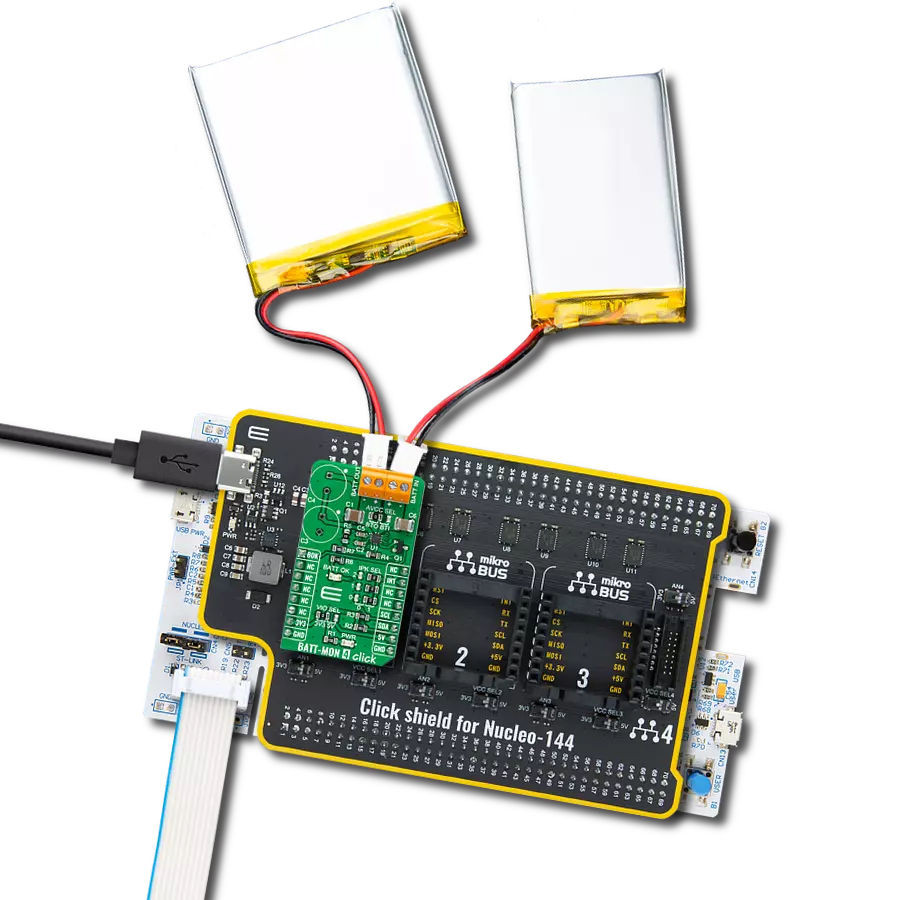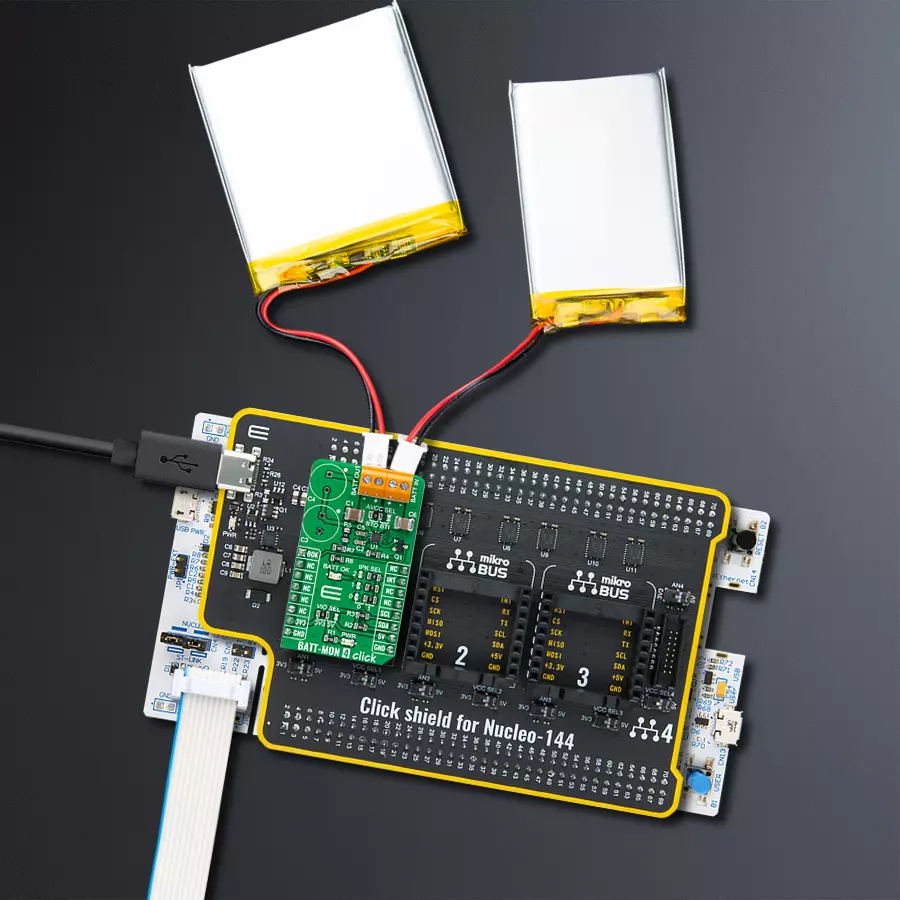Upgrade your solution with advanced battery diagnostics technology - predict end-of-service or early battery failure and stay ahead of potential issues
A
A
Hardware Overview
How does it work?
BATT-MON 4 Click is based on the LTC3337, a primary battery state of health monitor from Analog Devices, designed to be placed in series with a primary battery with minimal associated series voltage drop. The LTC3337 integrates a precision coulomb counter that monitors the accumulated charge transferred from a primary battery connected to its BATT IN terminal to an output load connected to its BATT OUT terminal. The patented infinite dynamic range coulomb counter tallies all accumulated battery discharge and stores it in an internal register accessible via an I2C interface. This Click board™ communicates with MCU using the standard I2C 2-Wire interface to read data and configure settings, supporting Standard Mode operation with a clock frequency of 100kHz and Fast Mode up to 400kHz. The LTC3337 also integrates additional state of health monitoring, which measures and reports through the I2C interface, such as battery voltage, battery impedance, and temperature, to quantify the battery's charge state and health. In addition, it also has a programmable discharge alarm threshold based on this state of charge (SOC).
When the threshold is reached, an interrupt is generated at the INT pin of the mikroBUS™ socket. An integrated coulomb counter operates with a configurable peak current limit. The LTC3337 supports input voltages from 1.8V to 5.5V and a peak current of up to 100mA; more precisely, the peak input current limit is selectable from 5mA to 100mA. The selection can be made by positioning SMD jumpers labeled IPK SEL to an appropriate position of 0 or 1. Coulombs can be calculated for either the BATT IN or BATT OUT terminal, determined by the selected position of the AVCC SEL jumper. The AVCC SEL is the power supply for all internal LTC3337 circuits and can be connected to the BATT IN or OUT terminal. With AVCC connected to BATT OUT, the coulomb counter counts all coulombs coming out of the battery, including those associated with the LTC3337's quiescent current, which effectively parallels the output load at BATT OUT. When connecting AVCC to BATT IN, the LTC3337's quiescent current represents an error on coulombs out of the battery. However, coulombs associated purely with the output load are now more accurately counted,
which may benefit output power metering applications. BATT-MON 4 Click also possesses one green LED indicator labeled as BATT OK used as a battery status indicator, alongside the option of utilizing a stack of two supercapacitors, C4 and C3, an integrated ±10mA supercapacitor balancer available to balance a stack of two supercapacitors at the BATT OUT terminal. This option is turned off by default with capacitors C4 and C3 unpopulated and resistor R5 populated. To activate this feature, remove the R5 resistor and populate C4 and C3 capacitors (an example of capacitors used on this board is SCCR20B335PRB). This Click board™ can operate with either 3.3V or 5V logic voltage levels selected via the VIO SEL jumper. This way, both 3.3V and 5V capable MCUs can use the communication lines properly. However, the Click board™ comes equipped with a library containing easy-to-use functions and an example code that can be used, as a reference, for further development.
Features overview
Development board
Nucleo-144 with STM32F767ZI MCU board offers an accessible and adaptable avenue for users to explore new ideas and construct prototypes. It allows users to tailor their experience by selecting from a range of performance and power consumption features offered by the STM32 microcontroller. With compatible boards, the
internal or external SMPS dramatically decreases power usage in Run mode. Including the ST Zio connector, expanding ARDUINO Uno V3 connectivity, and ST morpho headers facilitate easy expansion of the Nucleo open development platform. The integrated ST-LINK debugger/programmer enhances convenience by
eliminating the need for a separate probe. Moreover, the board is accompanied by comprehensive free software libraries and examples within the STM32Cube MCU Package, further enhancing its utility and value.
Microcontroller Overview
MCU Card / MCU

Architecture
ARM Cortex-M7
MCU Memory (KB)
2048
Silicon Vendor
STMicroelectronics
Pin count
144
RAM (Bytes)
524288
You complete me!
Accessories
Click Shield for Nucleo-144 comes equipped with four mikroBUS™ sockets, with one in the form of a Shuttle connector, allowing all the Click board™ devices to be interfaced with the STM32 Nucleo-144 board with no effort. This way, MIKROE allows its users to add any functionality from our ever-growing range of Click boards™, such as WiFi, GSM, GPS, Bluetooth, ZigBee, environmental sensors, LEDs, speech recognition, motor control, movement sensors, and many more. Featuring an ARM Cortex-M microcontroller, 144 pins, and Arduino™ compatibility, the STM32 Nucleo-144 board offers limitless possibilities for prototyping and creating diverse applications. These boards are controlled and powered conveniently through a USB connection to program and efficiently debug the Nucleo-144 board out of the box, with an additional USB cable connected to the USB mini port on the board. Simplify your project development with the integrated ST-Link debugger and unleash creativity using the extensive I/O options and expansion capabilities. This Click Shield also has several switches that perform functions such as selecting the logic levels of analog signals on mikroBUS™ sockets and selecting logic voltage levels of the mikroBUS™ sockets themselves. Besides, the user is offered the possibility of using any Click board™ with the help of existing bidirectional level-shifting voltage translators, regardless of whether the Click board™ operates at a 3.3V or 5V logic voltage level. Once you connect the STM32 Nucleo-144 board with our Click Shield for Nucleo-144, you can access hundreds of Click boards™, working with 3.3V or 5V logic voltage levels.
Li-Polymer Battery is the ideal solution for devices that demand a dependable and long-lasting power supply while emphasizing mobility. Its compatibility with mikromedia boards ensures easy integration without additional modifications. With a voltage output of 3.7V, the battery meets the standard requirements of many electronic devices. Additionally, boasting a capacity of 2000mAh, it can store a substantial amount of energy, providing sustained power for extended periods. This feature minimizes the need for frequent recharging or replacement. Overall, the Li-Polymer Battery is a reliable and autonomous power source, ideally suited for devices requiring a stable and enduring energy solution. You can find a more extensive choice of Li-Polymer batteries in our offer.
Used MCU Pins
mikroBUS™ mapper
Take a closer look
Click board™ Schematic

Step by step
Project assembly
Track your results in real time
Application Output
1. Application Output - In Debug mode, the 'Application Output' window enables real-time data monitoring, offering direct insight into execution results. Ensure proper data display by configuring the environment correctly using the provided tutorial.

2. UART Terminal - Use the UART Terminal to monitor data transmission via a USB to UART converter, allowing direct communication between the Click board™ and your development system. Configure the baud rate and other serial settings according to your project's requirements to ensure proper functionality. For step-by-step setup instructions, refer to the provided tutorial.

3. Plot Output - The Plot feature offers a powerful way to visualize real-time sensor data, enabling trend analysis, debugging, and comparison of multiple data points. To set it up correctly, follow the provided tutorial, which includes a step-by-step example of using the Plot feature to display Click board™ readings. To use the Plot feature in your code, use the function: plot(*insert_graph_name*, variable_name);. This is a general format, and it is up to the user to replace 'insert_graph_name' with the actual graph name and 'variable_name' with the parameter to be displayed.

Software Support
Library Description
This library contains API for BATT-MON 4 Click driver.
Key functions:
battmon4_get_die_temperatureThis function reads the chip DIE temperature in Celsius.battmon4_get_batt_in_voltageThis function reads the voltage from BATT IN when Ipeak is ON and OFF.battmon4_get_batt_out_voltageThis function reads the voltage from BATT OUT when Ipeak is ON and OFF.
Open Source
Code example
The complete application code and a ready-to-use project are available through the NECTO Studio Package Manager for direct installation in the NECTO Studio. The application code can also be found on the MIKROE GitHub account.
/*!
* @file main.c
* @brief BATTMON4 Click example
*
* # Description
* This example demonstrates the use of BATT-MON 4 Click board by reading
* the battery voltage and the chip internal temperature.
*
* The demo application is composed of two sections :
*
* ## Application Init
* Initializes the driver and logger.
*
* ## Application Task
* Reads the chip DIE temperature and voltage from BATT IN and BATT OUT and displays
* the results on the USB UART approximately once per second.
*
* @author Stefan Filipovic
*
*/
#include "board.h"
#include "log.h"
#include "battmon4.h"
static battmon4_t battmon4;
static log_t logger;
void application_init ( void )
{
log_cfg_t log_cfg; /**< Logger config object. */
battmon4_cfg_t battmon4_cfg; /**< Click config object. */
/**
* Logger initialization.
* Default baud rate: 115200
* Default log level: LOG_LEVEL_DEBUG
* @note If USB_UART_RX and USB_UART_TX
* are defined as HAL_PIN_NC, you will
* need to define them manually for log to work.
* See @b LOG_MAP_USB_UART macro definition for detailed explanation.
*/
LOG_MAP_USB_UART( log_cfg );
log_init( &logger, &log_cfg );
log_info( &logger, " Application Init " );
// Click initialization.
battmon4_cfg_setup( &battmon4_cfg );
BATTMON4_MAP_MIKROBUS( battmon4_cfg, MIKROBUS_1 );
if ( I2C_MASTER_ERROR == battmon4_init( &battmon4, &battmon4_cfg ) )
{
log_error( &logger, " Communication init." );
for ( ; ; );
}
log_info( &logger, " Application Task " );
}
void application_task ( void )
{
float die_temperature, batt_in_v_ipeak_on, batt_in_v_ipeak_off, batt_out_v_ipeak_on, batt_out_v_ipeak_off;
if ( BATTMON4_OK == battmon4_get_die_temperature ( &battmon4, &die_temperature ) )
{
log_printf ( &logger, " Die Temperature: %.2f C \r\n\n", die_temperature );
}
if ( BATTMON4_OK == battmon4_get_batt_in_voltage ( &battmon4, &batt_in_v_ipeak_on, &batt_in_v_ipeak_off ) )
{
log_printf ( &logger, " BATT IN \r\n Ipeak ON: %.1f mV \r\n Ipeak OFF: %.1f mV \r\n\n",
batt_in_v_ipeak_on, batt_in_v_ipeak_off );
}
if ( BATTMON4_OK == battmon4_get_batt_out_voltage ( &battmon4, &batt_out_v_ipeak_on, &batt_out_v_ipeak_off ) )
{
log_printf ( &logger, " BATT OUT \r\n Ipeak ON: %.1f mV \r\n Ipeak OFF: %.1f mV \r\n\n",
batt_out_v_ipeak_on, batt_out_v_ipeak_off );
}
Delay_ms ( 1000 );
}
int main ( void )
{
/* Do not remove this line or clock might not be set correctly. */
#ifdef PREINIT_SUPPORTED
preinit();
#endif
application_init( );
for ( ; ; )
{
application_task( );
}
return 0;
}
// ------------------------------------------------------------------------ END



































